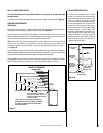
12
NOTE: DIAGRAMS & ILLUSTRATIONS NOT TO SCALE.
Figure 20
Figure 19 -
GAS CONNECTION
These appliances are equipped with a gas flex
line for use (where permitted) in connecting the
unit to the gas line. A gas flex line is provided to
aid in attaching the B-vent appliance to the gas
supply. The gas flex line can only be used where
local codes permit. See
Figure 19
for flex line
description. The flex line is rated for both natu-
ral and propane gas. A manual shut off valve is
also provided with the flex line.
The gas control valve is located in the lower
control compartment. To access the valve
proceed as follows:
1- Open the control compartment access panel,
(Figure 20 )
by actuating the spring-loaded
magnetic catches securing the panel, gently
depressing the outer top corners of the panel
until the catches "pop" the panel free and
allowing it to swing out and down to open.
2- Remove the bottom control compartment
access panel by compressing the spring-
loaded hinge pin on the left side until it
disengages from the left cabinet panel hole.
Pull the panel away from the fireplace.
See
Figure 20.
3- Remove the modesty panel by pulling the
bottom edge of the modesty panel out of
the locking slots of the cabinet bottom.
Then tilt the top edge at a 45° angel and
lift out. Remove the modesty panel care-
fully, so that none of the wires become
loose or disconnected.
The millivolt control valve has a ³⁄₈"
(10 mm) NPT thread inlet port. The electronic
control valve has a ¹⁄₂" (13 mm) NPT thread inlet
port and is fitted with a ¹⁄₂" x ³⁄₈" (13 mm x
10 mm) NPT fitting.
Secure all joints tightly using appropriate
tools and sealing compounds (ensure pro-
pane resistant compounds are used in pro-
pane applications).
Step 6. Outside Air Kits – Optional outside make-
up air kits, Model FOAK-4 or FAOK-4LD, may be
used with these appliances. Refer to the installa-
tion instructions packaged with the air kits for
specific installation information. If used, the out-
side air kit must be installed before the fireplace is
framed and enclosed in the finished wall.
Outside air drawn into the fireplace supplies
air to the fire for combustion. Only one outside
air duct is necessary, if installed. See the
Figures on pages 8, 9 and 10
for the location
of the units outside air inlet.
If additional length of duct is necessary, pur-
chase locally available U.L. Class 0 or Class 1
metallic ducting. The duct may extend up to 50'
(15.24 m) in any direction.
Note: When installing the air duct vertically,
DO NOT terminate the duct closer than 3'
below the chimney top.
Outside combustion air ducting may be run
upwards or vertically through framing and
ceiling joists, with the hood installed through
an outside wall and 3' (1 m) below the termi-
nation. Ducting may also be run downward
through floor Joists and under the home to a
ventilated crawlspace not considered part of
the living area of the home.
Note: Do not terminate outside air kit in attic
space under any circumstances.
Turn on gas supply and test for gas leaks using
a soapy water solution. Never use an open
flame to check for leaks.
A. Mix a 50% dish soap, 50% water solution.
B. Light the appliance (refer to the lighting
instructions provided in the Homeowner's Care
and Operation Instructions).
C. Brush all joints and connections with the
soapy water solution to check for leaks. If
bubbles are formed, or gas odor is detected,
turn the gas control knob to the “OFF” posi-
tion. Either tighten or refasten the leaking
connection and retest as described above.
D. When the gas lines are tested and leak free,
observe the individual tongues of flame on the
burner. Make sure all ports are open and
producing flame evenly across the burner. If
any ports are blocked, or partially blocked,
clean out the ports.
CAUTION: NEVER LOCATE INLET WHERE IT
CAN BE BLOCKED BY SHRUBS, SNOW
DRIFTS, ETC. NEVER LOCATE INLET IN GA-
RAGE OR ANY AREA WHERE THERE IS AN-
OTHER FUEL BURNING APPLIANCE OR PROD-
UCTS EMITTING COMBUSTIBLE GASES SUCH
AS PAINT, GASOLINE, ETC. IN COLD CLI-
MATES, IT IS RECOMMENDED THE COMBUS-
TION AIR DUCT BE INSULATED.
The hand operated outside air control lever is
located on the right side (EBVST, EBVPF, and
EBVCL) or left side (EBVCR) of the fireplace
opening.
See Figure 21 on page 13.
To open the outside air shutter, open the bottom
control access panel, reach into the gap between
the firebox bottom and the modesty panel, and
pull the outside air control lever all the way out.
After completing the installation of the op-
tional outside air vent system, the outside air
control lever must be put in service and tested
to ensure proper operation before completing
any enclosure around the firebox. Failure to
do so may result in extensive and costly re-
work. Before the operation of the vent system
can be tested, the lever securing screw must
be removed.
See Figure 21 on page 13.
Gas Stub
¹₂" x
³₈" Flare
Shut-Off Valve
³₈ Flex Tubing
³₈" NPT ₂ ³₈
Flare Fitting
³₈" Nipple
³₈"
Union
³₈" Close Nipple
³₈" Shut-Off Valve
¹₂
x
³₈
"
Reducer
Gas
Valve
Gas Flex Line Connector
Piezo
Ignitor
Gas Valve
Modesty
Panel
Control
Compartment
Access panel
ON/OFF
Switch
Hinge
Pin
Modesty Panel
Lock Slot


















